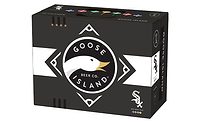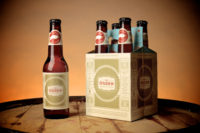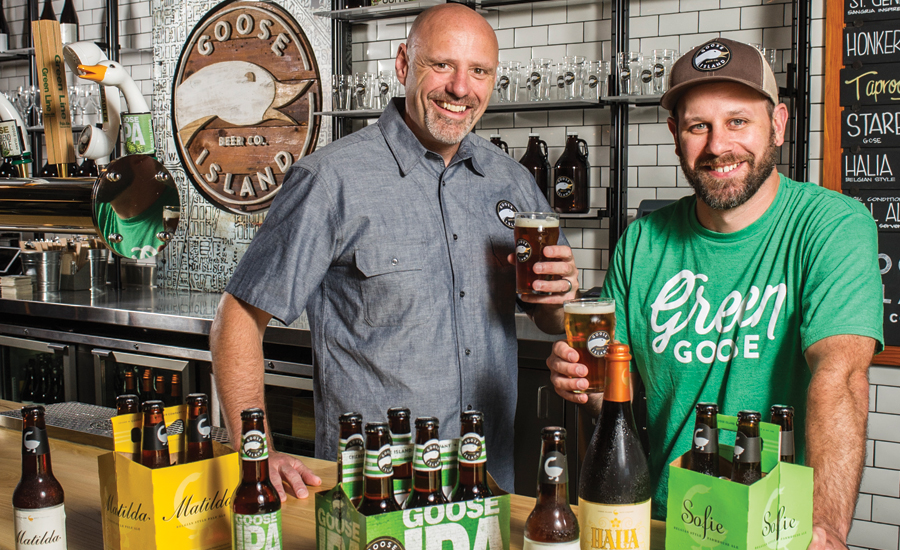Goose Island crafts award-winning beer
Chicago brewer expands portfolio and global footprint

Pictured left to right: Goose Island Beer Co.’s General Manager Ken Stout and Brewmaster Jared Jankoski. (Photo by Vito Palmisano)

Goose Island’s 143,000-square-foot Staviary, or barrel warehouse, contains hundreds of whiskey and wine barrels as part of the brewery’s barrel aging program. (Photo courtesy of Goose Island)






From a small brewpub that opened in Chicago’s Lincoln Park neighborhood in 1988, to large-scale brewing operations in Chicago and St. Louis, Goose Island Brewing Co. has made a name for itself in the beer market. Following its acquisition by Anheuser-Busch InBev (AB InBev) in 2011, the brewer still is crafting a variety of beer with more than 50 styles in its portfolio including expanding on the bourbon barrel aging program that it created close to 25 years ago.
“Goose Island originated and perfected formulating beer in bourbon barrels in 1992,” says Goose Island Brewmaster Jared Jankoski. “It began as a special beer to celebrate the 1,000th brew at Goose Island and was inspired by Greg Hall, son of founder John Hall, who had this wild idea to brew a beer big enough to stand up to a bourbon barrel.”
From this innovation, the dark and dense 14.2 percent alcohol by volume (ABV) Bourbon County Stout was born. Aged for eight to 12 months in a whiskey barrel, the imperial stout is a mix of charred oak, chocolate, vanilla, caramel and smoke, which adds a sweet and almost chocolatey note to the beer, Jankoski explains.
“With all the robust, big flavors of the whiskey, you need a beer that’s appropriately strong and robust to stand up to the whiskey barrel. What I love about Bourbon County Stout is that it’s a nice balance. It’s a beer that fits perfectly with the whiskey barrel,” he says.
Due to demand, production of Bourbon County Stout (BCS) and its other Bourbon County variants — Bourbon County Coffee, Bourbon County Barley Wine, Bourbon County Vanilla Rye and Proprietors Bourbon County Stout — never stops, Jankoski says. Brewed in gratitude for its Chicago fans, Proprietors BCS, in 2014, was made in rye whiskey barrels with cassia bark, cocoa nibs, panela and coconut water, he adds.
Goose Island’s barrel aging program has been so successful that last year it more than quadrupled its size, moving from the original barrel warehouse on Fulton and Wood to a new 143,000-square-foot facility, nicknamed the Staviary.
Back in 1992, Goose Island’s brewery operations moved from a brewpub in Lincoln Park to a brewery campus encompassing two city blocks on Chicago’s near west side. In May, the brewery opened a new taproom at this location as well. The iconic white goose logo is on brewing vessels, in its new taproom, on its glassware and on T-shirt, hats and other merchandise. The company’s slogan on signage inside and out proclaims, “We don’t need to be the only beer you drink. We just want to be the best beer you drink.”
That’s the motto the Goose Island team of 130 employees takes to heart every day. “We’re a company of beer lovers, but we also have a completely authentic level of warmth and camaraderie here,” says Ken Stout, general manager at Goose Island Beer Co. “We’re running three shifts, 24 hours a day using
32 fermenters and 15 yeast strains to produce a portfolio of 30 to 40 beers in Chicago alone.”
He estimates that Goose Island produced and shipped about 360,000 barrels last year and expects an increase of about 20 percent this year.
Goose Island’s portfolio includes the previously mentioned Bourbon County stouts, three Classic Ales including the Goose IPA and Honkers Ale, four seasonal beers, and three 312 urban ales along with Green Line Pale Ale. The brand’s seven Vintage Ales, barrel aged in a wine barrel, include Sofie, Matilda, Juliet, and Madame Rose. For its Illinois fans, Goose Island produces Chicago only brews such as the Illinois, the Ogden and the Muddy.
Goose Island craft beers are diverse, inspired by German, English and Belgian brewing traditions, with some beers that defy categorization because “we put an American twist and innovation into our beers,” Stout says.
“When we talk about our portfolio, we can look you in the eye and say with complete confidence that we have a true portfolio,” Stout says. “Many are in awe of the diversity of our craft beers.
“If you were tasting across our portfolio and you were blindfolded, you would have no idea that these beers were coming from the same brewery,” Stout continues. “Now that’s a portfolio.”
Thirsting for craft beer
Consumers are thirsting for craft beer like never before, and Goose Island is one of the leaders in the popular segment. Now ranked the No. 10 craft brewer, the Goose Island family of beers amassed sales of $43.7 million, up 9.5 percent from a year ago, in convenience stores and multi-outlets for the 52 weeks ending June 14, according to Information Resources Inc. (IRI), Chicago. Case sales totaled nearly $1.3 million, a
7.9 percent increase, based on IRI data.
For fiscal year ending Jan. 2, 2011, Goose Island generated revenue of $13.9 million and case sales of $463,332, 16 percent and 13.5 percent increases, respectively, versus the previous year. At that time, the brand was No. 15 on the craft beer segment list.
With great popularity comes great demand. Stout says one of the biggest challenges he’s faced has been keeping up with supply and demand.
“A lot of people will reflexively say, ‘oh, that’s a good problem to have’ and, in a way, it is,” Stout says. “It’s better than having too much inventory, but Hell hath no fury like wholesalers who order Goose Island beer and that order doesn’t show up because they have a lot of investment and equity in our brand, too.
“It’s part of their financial and buying plans for the year, the same with retailers,” he continues. “When a retailer orders a half barrel of Goose IPA and we can’t ship that product, they’re not going to hold that tap handle for us. It’s going to go to another brand and probably another brewery. We lose business and that’s a real problem.”
John Hall, Goose Island founder and chief executive officer, confronted the problem and weighed his options — seek out bank funding and venture capitalists or constrict the brewery’s footprint, which Stout stresses Hall absolutely did not want to do.
“At the time we got acquired, we had 110 full-time employees whose livelihood depended on Goose Island Beer Co., and that was something that John took seriously,” Stout says. “One Friday in May 2010, John got an unsolicited phone call from a little outfit in St. Louis — Anheuser Busch — and the proposition was made to John. ‘Hey, we understand what your challenges are, you can’t keep up with demand, well, we’ve got solutions.’”
After careful deliberation, Hall and son Greg, a former Goose Island brewmaster, concluded that Goose Island’s best option was to be acquired by AB InBev, Levuen, Belgium. As a brewery itself, AB InBev could help Goose Island build capacity and acquire resources it didn’t have before, Stout says.
In what was the largest acquisition of the year for small breweries, AB Inbev announced in March 2011 that it would acquire Goose Island. However, the two brewpubs in Lincoln Park and Wrigleyville were not part of the deal and remain open as independent operations still owned by John Hall.
Global beer brand
In doing so, Goose Island became the first craft brewery acquired by a brewery with a global presence. “When we first got acquired, it was big news,” Stout says. “While there was some initial trepidation, the overriding benefits have been significant.”
He points out that Goose Island now can access national markets with good planning and foresight. Prior to the acquisition, Goose Island was available in 22 states. Now it is a global beer brand distributed in 50 states along with a few export markets, including Canada, the United Kingdom and Brazil, with plans for further expansion.
IPAs are the most popular, fastest growing beer in the craft beer segment, Stout says. Due to high consumer demand, Goose Island’s Honkers Ale, 312 Urban Wheat and some seasonal rotations are made at AB InBev’s state-of-the-art brewing facilities, Stout says.
“We’ve always made great beers at Goose, but even our brewers would tell you that the beers we’re making now at Anheuser-Busch facilities are even more consistent, cleaner and better tasting than before.” Stout says. He attributes this to superior quality control, quality assurance and an expansive physical plant with a strong packaging, marketing and distribution system.
Even with the acquisition, Stout stresses that Goose Island beers are still Goose Island beers. “Goose Island brewers are 100 percent charged with our brewing process, our recipes, our ingredients and coming up with innovations,” he says. “Our programs are funded by Goose Island revenue and Goose Island delivery of the gross profit.”
Blending science with art
Brewmaster Jankoski says that there’s significant clamor and demand for American craft beers in the United States and around the world.
As a result, Jankoski and his 24-person team take the science and art of crafting Goose IPAs, urban ales, bourbon stouts and vintage ales seriously.
Since 1989, Goose Island has earned 105 medals from competitions at the Great American Beer Festival (GABF), the World Beer Cup and others.
Stout recalls that when the new Bourbon County Stout was shipped to GABF, it got disqualified because it did not meet the then-specifications for a stout. “The alcohol was too high. It got an honorable mention from the judges who said, ‘We can’t give you an award in the stout category because you’re outside of the specs, but you guys are onto something here.’”
Today, there’s close to 20 categories at the GABF for barrel aged beer, but in the late 1980s and early 1990s, that was not the case, Stout says, giving the Goose Island barrel aged products even more prominence in the craft beer landscape.
Yet, Stout and Jankoski want to make Goose Island beers even more inclusive.
“There are a few emerging trends in the craft beer industry that coincide pretty well with my personal taste in beer,” Jankoski explains. “Craft had gone in the direction of bigger is better and you saw beers getting hoppier and stronger and people started to associate that with the craft beer industry.”
Yet, Jankowski believes that is not an exclusive way to look at craft beer, and he’s glad that trends are embracing sessionable beers like session IPAs, which are lighter beers in alcohol content — but not too light.
“I want everyone to be drinking the beer we make and that means embracing the typical consumer,” Jankoski says. “Whether you’re a busy mom, an urban professional or a woodsy fellow from Montana, I hope that everyone can enjoy craft beer. I think people who haven’t developed the palate to appreciate more complex or stronger beers have a hard time approaching craft beer. We want to change that.”
Jankoski explains that there isn’t much difference in its brewing process in Chicago versus the brewing process in other craft breweries. “But what sets Goose apart is that we use 50 different varieties of hops and malts and up to 20 different yeast strains. Most craft breweries don’t do that,” he says.
Jankoski explains that most breweries are using about two to four yeast strains, and because the yeast accounts from anywhere from 50 to 70 percent of the flavor profile, it is the yeast that defines the beer.
Beer’s high-demand raw material, hops, also is crucial to the brewing process, he says. Many of the brewery’s hops, including Amarillo, Pilgrim, Cascade and Centennial, are sourced from its very own Elk Mountain Farms in Idaho. “It’s a gorgeous farm with a passionate staff,” Jankoski says. “They provide us with some hard-to-find hops and also have an experimental yard, so we can continue to innovate and create the next best craft beer.”
Barrel aging sets Goose apart
Jankowski and Stout say the No. 1 reason for Goose Island’s success is the quality of the beer and the inclusive culture that John Hall built when he founded the company.
Innovation also has played a key role in the brand’s success. “The barrel aging process is positively one of the pillars we stand on,” Stout says. “It’s tough to do and takes a long time, but there’s demand for these beers all over the globe.”
In addition to the Bourbon County stouts and all of its variants, Goose Island spearheaded the use of wine barrels in a similar way as its bourbon barrels.
“We haven’t scientifically proven this, but we feel that the terroir of Chicago gives us a little bit of integration with the wood throughout the seasons.” Jankoski says. “Our bourbon barrels are kept unclimate controlled so the wood breathes the beer in and out, giving it an exchange of characters.”
Although wine barrel brewing is done by a handful of breweries nationally, Jankoski notes that Goose Island is producing the brand’s wild and sour ales on a much larger scale.
“We’re allowing the bacteria and wild yeast to impart their very unique flavors in the beer and to integrate with the fruit and base beer, which brings some really unique elements to those beers,” he says.
As Goose Island experiments with new ingredients and processes, constant innovation is crucial.
“We have over 90 projects we’re working on, and we’re tasting them as they’re maturing,” Jankoski says. “This could be anything from beers that we’re making in our little two-barrel pilot system to a 50-barrel trial. We may not have a place for them in our lineup initially, but it just becomes an arrow in our quiver.”
Stout echoes similar sentiments. “As a brewery, we want to offer beers for as many occasions as we can because beer is so versatile. With even more than 2,000 identifiable flavor compounds, beer is a more complex beverage than wine,” he says. “We’re going to keep making great beer and making friends for Goose Island. The sky’s the limit.”
Jankoski concludes, “Even on your worse days, you have take a minute and say, ‘We make beer for a living,’ and that’s a very good thing.”
Looking for a reprint of this article?
From high-res PDFs to custom plaques, order your copy today!











